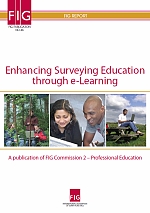| |
FIG PUBLICATION NO. 46
Enhancing Surveying Education through
e-Learning
A publication of FIG Commission 2 – Professional
Education
Contents
Foreword
Introduction
1. The concept of e-learning
1.1 E-learning defined
1.2 Policy considerations
1.3 Continuing professional development
1.4 Knowledge management
1.5 Learning at workplace
1.6 Organizational learning
2. The nature of e-learning
2.1 Trend from technology to pedagogy
2.2 Reusability
2.3 Metadata
2.4 Learning Content Management System
2.5 Web 2.0
2.6 Standards
3. E -learning technology and infrastructure
3.1 Internet
3.2 Learning management systems
3.3 (Multi-media) software for course development
3.4 Virtual libraries
3.5 E-learning infrastructure
3.6 End-to-end model for e-learning
4. Effective e-learning
4.1 Networking, organizational issues
4.2 Business models
4.3 Benefits
5. Role of e-learning in Surveying
5.1 Awareness building
5.2 Platform for collaboration
5.3 Sharing good practice
5.4 Creating a learning community
5.5 The growing importance of life-long-learning
6. FIG Policy on e-learning
References
Case of Good Practice 1:
UNIGIS
Overview
Clearly defined professional qualifications
Curriculum development
Distance learning
Quality assurance
References
Case of Good Practice 2:
ESRI – The Virtual Campus
A history of successes
Challenges and shortcomings
The way ahead
Authors
Orders for printed copies
Surveying is one of the oldest professions. Traditionally land surveyors
are professionals who determine or establish points, lines, polygons of the
selected real word objects, who collect their attribute data, who register
the rights on those and visualize the results. To fulfil the needs of the
society usually surveying schools were one of the first higher educational
institutions in the field of engineering in every country. On the one hand,
to process raw measurements a very high level of mathematical background was
needed. That is why so many mathematicians are in close contacts with
surveying. On the other hand data processing needed special devices like the
abacus, the logarithmic table, the mechanical calculator etc.
At the middle of the last century a new device was introduced: the computer.
It changed dramatically first our computational habits in sixties, and
afterwards the mapping devices and the data processing practice as a whole new
way of thinking. In the seventies the remote sensing satellites and in the
eighties the Global Positioning System (GPS) generated more basic changes. The
introduction of Internet and the rapid changes of Information and Communication
Technologies (ICT) caused yet another fundamental transformation of surveying.
Nowadays the computers are used only for a very little percentage for computing.
They are totally integrated into our workflow, serving us within data
acquisition, database developments, data processing, data analysis and
visualization. Through the computer networks our profession serves the
e-Society.
In the last fifty years computers have changed the work of surveyors totally.
As usual the way of thinking is always a little bit behind the possibilities.
The aim of this publication is to summarize the results of FIG Commission 2 on
the field of computer uses in surveying education, to help academy and surveying
industry to more quickly make the transformation from traditional teaching and
learning to e-learning.
This publication aims to support FIG community with basic knowledge on
e-learning and declares the FIG policy in this field. The content is a summary
of lessons learned in e-learning during the last FIG events, basically at the
workshop in Enschede, June 2008. We would like to thank for all the contributors
of this publication, but pre-eminently Prof. Steven Frank, Dr.
Reinfried Mansberger, Dr. Adrijana Car, Dr. James Petch and
Nicholas Frunzi.
January 2010
Stig Enemark
FIG President |
Bela Markus
Chair, FIG Commission 2 |
Liza Groenendijk
Chair, FIG Working Group 2.2 |
Developments in ICT had a huge effect on the surveying profession (Markus,
2008). New technologies and new opportunities have enabled surveyors to broaden
their skills and competencies. The number of competencies in which surveyors
might claim to be proficient now number over 200 (Mahoney et al, 2007). The
rapid changes in the profession have created a growing need for continuous
changes in education and an increasing demand for continuing professional
development (Markus, 2008).

ICT and the impact on the surveying profession and professional education.
Enemark (2007) summarizes the major key international trends in the surveying
education as follows:
- management skills, versus specialist skills
- project organized education, versus subject based education
- virtual academy, versus classroom lecture courses
- lifelong learning, versus vocational training.
Fairly (2009), advocating a clear, concise surveying profile for the future,
distinguished two major changes taking place across Australia and the EU:
internationalization and interoperability. Surveyors of today work in an
increasingly global market and the profession has grown rapidly beyond cadastral
surveying, with increasing application of surveying and mapping technologies in
other sectors.
Lifelong learning has become a buzz-word and a well established concept for
continuous professional development of staff engaged in surveying institutions
and other land professionals (Osskó, 2008). E-learning methods and tools have
been introduced and are now playing an increasing role in professional
education.
E-learning is one of the main themes in FIG Commission 2 – Professional
Education (Markus, 2008). Several FIG events in the past years were dedicated to
e-learning or related topics such as curriculum design, knowledge management,
and management of education. This technical report summarizes the outcomes of
the Commission’s workshops, symposia and working groups. The report aims to
bring together the experiences and viewpoints within FIG on the role of
e-learning in surveying education. The intention of the report is to support FIG
members and their affiliates and the surveying public in general in their
efforts to further develop e-learning initiatives within their organisations.
The steps for taking a data model through its conceptual, logical, and
physical phases, including modelling the user’s view, defining objects and
relationships, selecting geo-graphic representations, matching geo-database
elements, and organizing the geodatabase structure are used as guidelines for
building the structure of this publication.
The report will start in chapter 1 with a general explanation of the concept
of e-learning; this is followed by a more in-depth description on the nature of
e-learning in chapter 2. In chapter 3, e-learning technology and infrastructure,
the more practical aspects of e-learning are covered, with in chapter 4 a
discussion on effective e-learning. Chapter 5 is dedicated to role of e-learning
in surveying and in chapter 6 the FIG policy on e-learning is presented. Many
issues presented in these chapters come back in the two examples of best
practices in e-learning in surveying at the end of the publication: Case of Best
Practice 1, UNIGIS, and Case of Best Practice 2, ESRI.
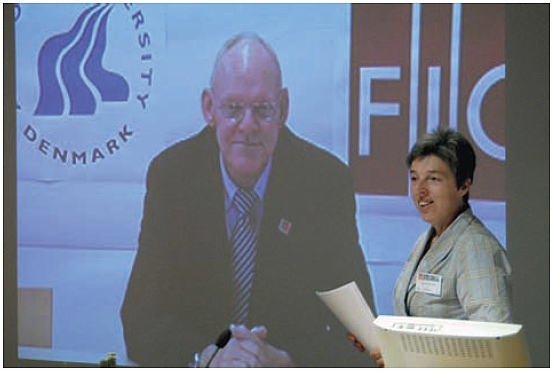
FIG President Stig Enemark delivering his opening speech from a distance by
using Video Conferencing (FIG Workshop Sharing Good Practices, Enschede, the
Netherlands, June 2008). In the front Liza Groenendijk, editor of this
publication. © ITC.
1. The concept of e-learning
1.1 E-learning defined
Markus (2008) defines e-learning as follows: “– – e-learning is a learning
process created by interaction with digitally delivered content, network-based
services and tutoring support. This definition focuses on the revolutionary
impact of network-enabled technology. Adding more details on methodology:
e-learning is any technologically mediated learning using computers whether from
a distance or in face to face classroom setting (computer assisted learning), it
is a shift from traditional education or training to ICT-based personalized,
flexible, individual, self-organized, collaborative learning based on a
community of learners, teachers, facilitators, experts – –.”
Central in this definition are two aspects of e-learning:
- e-learning as computer assisted learning, and
- e-learning as pedagogy for student-centred and collaborative learning.
These aspects in fact summarise the development of e-learning in time. Early
developments in e-learning focussed on computer assisted learning, where part or
all of the learning content is delivered digitally. More recently the
pedagogical dimension of e-learning has become prominent.
1.2 Policy considerations
E-learning has become popular because of its potential for providing more
flexible access to content and instruction at any time, from any place (Means et
al, 2009).
Frequently, the focus entails:
- increasing the availability of learning experiences for learners who
cannot or choose not to attend traditional face-to-face offerings,
- assembling and disseminating instructional content more
cost-efficiently, or
- enabling instructors to handle more students while maintaining learning
outcome quality that is equivalent to that of comparable face-to-face
instruction.
If student outcomes are the same whether a course is taken online or
face-to-face, then online instruction can be used cost-effectively in settings
where too few students are situated in a particular geographic locale to warrant
an on-site instructor (e.g., rural students, students in specialized courses).
1.3 Continuing professional development
The potential role of e-learning in Continuing Professional Development was
already mentioned in the FIG Policy Statement on CPD published in 1996. And the
experiences within Commission 2 has shown that this was not just a nice policy
idea at that time, but that e-learning has proven to fit perfectly with the
concepts of life-long-learning or continuing development. It has proven to be a
flexible mode of learning for professionals. Due to the high flexibility in
time-, site- and learning aspects, e-learning is a proper tool and an essential
driving force for the realisation of life-long learning.
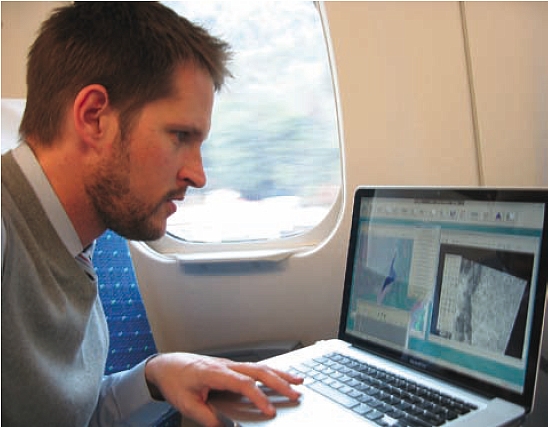
© Ballatore
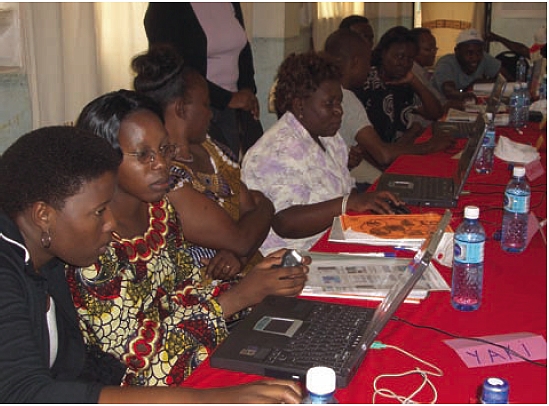
© Verplanke
E-learning in surveying: anywhere, any time and any one. Student Working on an
assignment for his distance course at 300 km/hr in a bullet train in Japan (top)
and students in Ghana participating in an online course with local facilitation
(bottom).
1.4 Knowledge management
In the dynamically changing world of business, the competitiveness of
companies (and/ or universities) depends heavily on the possibility to find, for
a given problem, the right knowledge in the right moment. By using a Knowledge
Management System (KMS), organisations increase returns, save time and money,
are more adaptable, and have a far better understanding of partners, processes,
customers, competitors and their business. To benefit from every customer or
partner interaction, corporations must give employees the opportunities to
record what was learned. Efficient knowledge management needs not only document
knowledge but must provide tools for collaboration among all contributors to the
knowledge pool. Then, other employees must have access to the data and the means
to understand it in context. Knowledge management helps an organisation gain
insight and understanding from its own experiences. When employees use KMS, best
practices are stored throughout the organization, and each employee accessing
the system has similar power to the best employee (Markus, 2002).
1.5 Learning at workplace
Daily tasks are evolving faster than universities can produce qualified
graduates. Many employers apply constant, on-the-job training to remain
competitive. E-learning programs help staff members to obtain new skills and
critical improvements quickly and efficiently.
Companies integrate e-learning into the mainstream. They can easily
amalgamate learning modules into staff communications, and can add similar tools
to web-based systems.
E-learning opens the world. Likewise, small businesses can access the same
level of knowledge and insight that was earlier only available to large
companies.
Mobile technology helps e-learning initiatives. Wireless technology allows
educators to reach learners in their working environment.
The ESRI Case (see the appendix) gives an excellent insight in the role and
development of e-learning to support workplace learning.
1.6 Organizational learning
Organizational Learning (OL) is a powerful tool to improve the performance of
an organization. In general there are two different processes of organizational
change that are associated with organisational learning:
- adaptive learning, where changes are made in reaction to changed
conditions and
- pro-active learning, i.e. organizational changes that have been made on
a more intentional basis.
Adaptive learning is seen as a process of incremental changes, more automatic
and less cognitively induced than proactive learning. Proactive learning which
goes beyond the simple reacting to environmental changes.
2. The nature of e-learning
2.1 Trend from technology to pedagogy
Early developments in e-learning focussed on computer assisted learning,
where part or all of the learning content is delivered digitally. These type of
e-learning activities can be classified according to its objective – whether the
activity serves as a replacement for face-to-face instruction (e.g., a virtual
course) or as an enhancement of the face-to-face learning experience (i.e.,
online learning activities that are part of a course given face-to-face) (US
Department of Education, 2009; Verkroost, 2009).
More recently the pedagogical dimension of e-learning has become prominent.
Learning experiences can be classified in terms of the amount of control that
the student has over the content and nature of the learning activity. In
traditional or expository learning experiences, content is transmitted to the
student by a lecture, written material, or other mechanisms. Such conventional
instruction is often contrasted with active learning in which the student has
control of what and how he or she learns. Another category of learning
experiences stresses collaborative or interactive learning activity in which the
nature of the learning content is emergent as learners interact with one another
and with a teacher or other knowledge sources.
Typically, in expository instruction, the technology delivers the content. In
active learning, the technology allows students to control digital artefacts to
explore information or address problems. In interactive learning or
collaborative learning, technology mediates human interaction either
synchronously or asynchronously; learning emerges through interactions with
other students and the technology (US Department of Education, 2009). Both
active and interactive learning approaches are student-centred and make use of
online learning models supported by Web 2.0 technologies. Blended learning
combines e-learning with face-to-face learning and other learning mechanisms. It
can include the use of audio, video, documents, software, and "hands-on”
experiences.
Blended learning recognizes that some learning experiences are not
appropriate to e-learning and need be taught in other fashion. For example,
learning how to measure angles with a theodolite is greatly enhanced by
physically operating the theodolite in practice – setting the instrument
precisely over a point and precisely pointing the instrument at various objects
to be measured. (Lam 2008).
2.2 Reusability
One of the great advantages of digital medium is the ease of storage and
reusability of teaching materials or “learning objects.” Keeping learning
objects on file is done with a push of a button. Upgrading and redeveloping
materials is simple and easy. To be reusable, e-learning objects should be
easily disassembled and reassembled. Users should be able to easily mix
materials from multiple sources without dependence on proprietary systems
(Hodgins and Conner 2000).
Chiappe (2007) defined Learning Objects as: “A digital self-contained and
reusable entity, with a clear educational purpose, with at least three internal
and editable components: content, learning activities and elements of context.
The learning objects must have an external structure of information to
facilitate their identification, storage and retrieval: the metadata. “
Beck (http://en.wikipedia.org/wiki/Learning_object)
suggests that learning objects have the following key characteristics:
- Learning objects are a new way of thinking about learning content.
Traditionally, content comes in a several hour chunk. Learning objects are
much smaller units of learning, typically ranging from 2 minutes to 15
minutes.
- Are self-contained – each learning object can be taken independently.
- Are reusable – a single learning object may be used in multiple contexts
for multiple purposes.
- Can be aggregated – learning objects can be grouped into larger
collections of content, including traditional course structures.
- Are tagged with metadata – every learning object has descriptive
information allowing it to be easily found by a search.
There is general trend from long to short in building learning objects. Nano
learning (n-learning) is the latest term in the natural progression: from
learning, distance learning (d-learning), flexible learning (f-learning),
electronic learning (e-learning), blended learning (b-learning), and the recent
addition, (mobile) m-learning.
2.3 Metadata
Metadata is data about data and the time of production. It describes the
content of data, the data producer, and the purpose(s) for which the data was
produced. Typical
e-learning metadata allows the potential user (instructor or student) to
assess the quality and suitability of e-learning materials. Metadata would
describe the creator, the intended purpose or possible uses of the material, the
date the material was created and other relevant factors. The purpose of
metadata is to allow potential users to quickly and easily find and evaluate
e-learning objects.
Metadata can be used to improve the search process, to build user-specific,
guided paths, and to maintain relationships among disparate educational
resources. Several metadata projects are under development to target and
standardize the instructional qualities that are most useful in describing
educational resources. The efforts of these projects will provide a metadata
foundation that can be leveraged by future instructional applications. It is
obvious that the continued success of the Internet is contingent upon automated
tools that efficiently guide the information gatherer toward relevant and
appropriate material (Markus, 2000).
2.4 Learning Content Management System
The knowledge base for surveying is vast and not completely defined. The
materials used to form an e-learning experience come from a wide variety of
sources. In some cases, they are merely text copied from published textbooks
and/or manuals. In other cases they may be presentations such as PowerPoint
slides or handouts, live or recorded digital audio, or live or recorded digital
video. The knowledge base can be in modular or course form with modular form
(e.g. learning objects) being the recommended format. The knowledge can be built
by the instructor, borrowed from a virtual library, or purchased from a vendor.
In a Learning Content Management System all the materials can be organised and
easily accessed.
2.5 Web 2.0
In the past few years a new wave of internet technology, Web 2.0, has emerged
with the potential to further enhance teaching and learning environment in
higher education (Ajjan & Hartshorne, 2008). With the use of Web 2.0 students no
longer access the web only for course information and content; they can do much
more. Students access the web, collect different pieces of information and
create new information that could be shared with others. Web 2.0 applications
replace the traditional passive modes of content delivery, such as posting
lecture notes and videos, with the knowledge generated by the group. Examples of
Web 2.0 technologies include wikis, blogs, instant messaging, internet
telephony, social networking sites, podcasting and online media sharing
(Groenendijk, 2009).
Blogs (abbreviated from weblogs) are web-based publications consisting
primarily of periodic articles (normally in reverse chronological order)
containing text, images and links to web content, such as websites or other
blogs. Blogs have a variety of formats and might include the user expressing
their opinion about a topic or documenting activities. Blogs are often used as
online diaries. Blogs are interactive in the sense that other users could
provide comments on the information posted by the blog author. Educational
applications of blogs include researching, tracking, interpreting, and
evaluating blogs for political commentary, cultural events, business, or other
news and for examining changes over time. Blogging is now being used as a tool
for students to keep records of their learning. They also allow feedback from
instructors and other students. Blogs can be used by single students or by
groups of students to share ideas, progress on projects, or to pose questions
(Ajjan & Hartshorne, 2008; Kottyan, 2008).
Wikis (What I Know Is) refer to collaborative
websites that allow users to interact by adding, removing, or editing site
content. The most well-known wiki implementation is Wikipedia (http://wikipedia.org/).
A wiki is a type of website that allows anyone visiting the site to add, to
remove, or otherwise to edit all content, very quickly and easily, sometimes
without the need for registration. This ease of interaction and operation makes
a wiki an effective tool for collaborative learning and collaborative writing.
Wiki is popular software that can be used for student collaboration on projects.
Wiki allows multiple users to work on the same document(s) from several
locations, offering a platform for online group work with students from all over
the world in distance education courses (Molendijk, 2008). Wiki’s allow students
to work on documents or presentation media collectively, with a history of
changes always available (Cepek and Pytel, 2006).
Instant messaging (IM) is a collection of technologies that create the
possibility of realtime text-based communication between two or more
participants over the internet or some form of internal network/intranet. – Chat
happens in real-time. IM allows effective and efficient communication, featuring
immediate receipt of acknowledgment or reply. In certain cases Instant Messaging
might involves additional features, which make it even more popular, i.e. to see
the other party, e.g. webcams, or to talk directly for free over the internet
(Yahoo! Messenger, Windows Life Messenger, Skype).
Social networks allow users to create personal profiles and establish a
variety of networks that connect him/her with family, friends, and other
colleagues. Users of Hyves, Facebook, or LinkIn, for example, utilize these
sites to stay in touch with friends, make plans, and find new friends, to find
old schoolmates or to maintain and extend their professional network. A recent
newcomer in social networking is Twitter: a free social networking and
micro-blogging service that enables its users to send and read messages known as
tweets (http://wikipedia.org/, accessed
31.08.09).
Podcasting and webcasting, created either by instructors or by students, are
another new phase in e-learning. While the term comes from a blend of the terms
iPod and broadcasting any computer capable of viewing multi-media electronic
files are used as the instruction medium. Students can produce presentations
that can be shared with other students. Students download the podcasts, which
can be either audio or video or both, to view inside or outside the classroom
(Frank, 2009). Podcasts are developed by lecturers for guiding students during
practical work in the field.
Media sharing websites such as YouTube allow students to find informative
videos or to create short videos films that can be shared with the world.
Teachers use YouTube to publish educational videos or refer to videos with
interesting content, demonstrations or complete courses1.
Online applications, such as Google Earth and other Virtual Globes, offer
excellent opportunities for e-learning in surveying and geospatial information
education (Groenendijk, 2009).
1) Follow the next links
for the recordings of the opening speech by video conference by FIG President
Stig Enemark at the FIG Workshop in Enschede, the Netherlands, June 2008:
http://www.youtube.com/watch?v=eDqXKgSktXY and
http://www.youtube.com/watch?v=RYEU-SJbyiw&feature=related
2.6 Standards
A learning object could be a text file, a videotaped lecture or a computer
exercise. The Learning Object Standard addresses the accessibility, reusability
and interoperability of learning objects. Accessibility refers to the use of
metadata so that learning objects can be identified and evaluated. Reusability
allows a learning object to be used in different instructional contexts.
Interoperability requires that the learning object be independent of both the
delivery system and the knowledge management system (Polsani, 2003). The premise
is that educational components could be built that would be reusable in many
contexts. Users would be able to combine learning objects to create a new
educational experience such as a course, seminar, etc. (Wiley, 2000).
The Sharable Content Object Reference Model (SCORM) defines, packages and
manages learning objects. Sharable Content Objects are another term for
e-learning objects. The standards addresses how these objects can be created to
be reusable across a variety of learning systems. Included in the standards are
methods of packaging data for multiple uses, compressing (zipping) data for
transfer, and sequencing data for student acquisition (SCORM, 2004).
3. E -learning technology and infrastructure
As mentioned in earlier chapters, the basis of e-learning is digital
technology – computers and computer networks. The Internet allows one to reach
out across town or across continents to deliver e-learning courses. Broadband
computer networks allow vast quantities of data to be moved quickly and
efficiently from computer to computer. Advances in computer software and
hardware allow new and innovative approaches to teaching and learning. This can
present problems as some parts of the globe do not have broadband Internet
access and/or do not have dependable sources of electricity to run their
computers (Olaniyi, 2006).
3.1 Internet
When discussing e-learning technology, the Internet easily comes to mind.
There is a trend among the Internet community to redesign the whole Internet
system be one gigantic e-learning system. In most cases, the Internet offers the
most efficient and cost effective method of conducting e-learning. Beyond having
the ability to interconnect computers is the need to have the interconnection in
such a way that e-learning can be effectively and efficiently managed. This
happens in some part through the standards
discussed in Chapter 2 and in other parts by use of vendor or open platform
software specifically developed for e-learning purposes. Special software for
organizing e-learning (called platforms) can be used to manage e-learning.
E-learning is, for the most part, dependent on the Internet. Broadband
Internet access is necessary to use most e-learning objects other than text
documents. This can still be a problem in some parts of the world. E-learning is
made simpler by the use of Learning Management Systems (LMS) which can create
portals on the Internet through which students can easily find and access
learning objects. These systems, often called e-learning platforms, are placed
at the portals to allow instructors and administrators to organize and deliver
educational courses.
3.2 Learning management systems
E-learning platforms are software that organize and automate many of the
activities associated with e-learning. These platforms can be organized in a
variety of ways. E-learning platforms offer users a structure that can be easily
adapted to multiple uses from augmentation of “brick and mortar” education to
stand-alone training exercises. They allow easy organization of e-learning
materials with relatively easy user interaction (Milenov and Kay, 2008).
Students may use them to work on group projects, take online quizzes and
examinations, and turn in assignments (Markus, 2006). They can allow students to
register for classes, pay for classes, and take classes all online. They can
allow educators to present learning materials, monitor student activity and
assess student learning (Australian Flexible Learning Community 2002). The
platforms are commercially available (like WebCT, Blackboard) or Open Source
(Moodle, etc.).
Initially learning management systems were dominated by content, but over the
last four to five years Web 2.0 features were added to facilitate communication
and collaborative learning. Internet discussion boards and forums, chats, wikis
and blogs are common collaborative learning tools integrated in the learning
management systems.
Discussion boards can be used both formally and informally in e-learning.
Students are able to discuss their understanding of topics with other students
and with instructors outside of the virtual classroom.
An example of the use of Web 2.0 tools in distance education is Virtual GEO,
an educational portal of the University of West Hungary. The portal is based on
the open Learning Management System Moodle and makes use of blogs and wikis
(Kottyan, 2006, Kottyan, 2008). The Institute of Surveying, Remote sensing and
Land Information at the University of Natural resources and Applied Life
Sciences, Vienna, also make use of Moodle. An evaluation their e-learning
experiences with communication tools in Moodle is presented by Mansberger et all
(2008).
Skype, and different kinds of messengers, allows audio/visual group
communication. Similar to a conference call with telephones, Skype conference
calls allow cheap, realtime communication. A simple webcam can be added at the
instructor’s computer to give visual capabilities so that students can see
demonstrations and lecture. Additional cameras at students’ computers allow
face-to-face interchange between the instructor and students (Todorovski 2008;
Wahlstrom 2008).
3.3 (Multi-media) software for course
development
There are literally thousands of software applications available for building
and managing e-learning courses. Most of the conventional software applications
used for learning and business, such as word processors, slide presentation
software, video software and others can and have been adapted to create material
for e-learning courses. A plethora of new software applications aimed directly
at creating e-learning courses and materials have also emerged. Companies like
Adobe, Articulate, imc AG, Lectora, RapideL and SoftChalk, to name a few, make
software specifically aimed at developing e-learning applications. Most of the
software appear to support the standards discussed in chapter 2.6.
The trend is towards open source and web-based learning. Online applications,
such as Google Earth, that focus on geospatial information, are being designed
for e-learning and are being incorporated into e-learning exercises.
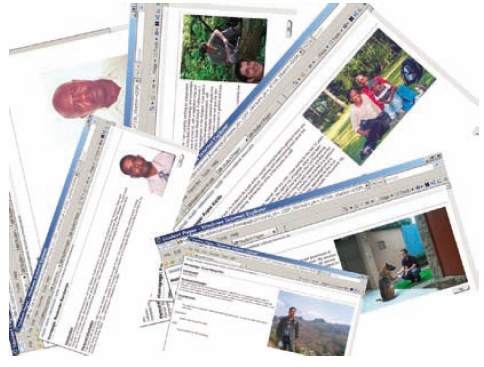
Personal homepages of online students available to all in the Learning
Management System. © Boerboom
3.4 Virtual libraries
Repositories of digital information (virtual libraries) can be accessed to
assist e-learning. Originally developed by converting brick and mortar library
records to electronic form, they have expanded to include a vast array of
digital information and data. Specialized virtual libraries contain electronic
records specific to one or more related topics. FIG maintains a virtual library
of papers presented at FIG workshops, annual working weeks and conferences.
Virtual libraries are indexed databases of electronic educational materials.
They are places where instructors, researchers and students go to find
electronic publications on research, theory, history and other important aspects
of a particular theme. In cases where the learning material is not in electronic
form users may search and order or reserve copies of the materials. Most
academic and national libraries have developed virtual capabilities where
electronic copies library resources may be downloaded. Virtual libraries can
contain digital copies of textbooks, audio, video, software, datasets and other
resources that can be quickly accessed by people all over the world. Language
will always be a barrier to some but virtual libraries are being developed in
most of the World’s major languages.
In addition to traditional libraries being put online in electronic format,
new virtual libraries are being developed as repositories of learning and other
materials. In the United States, as in many other countries, a national
geospatial data clearing house has been established with links to various local,
state and national geospatial data including survey, mapping, and GIS data. The
sites are maintained primarily by government agencies and provide a wealth of
geospatial information. These materials are being incorporated into many
e-learning courses.
Other new virtual libraries are being developed that are repositories of
e-learning materials. Structure on the IEEE Learning Object model, they allow
access to learning objects and learning object metadata. These libraries consist
of e-learning objects that can be accessed and reassembled to modify existing
courses or to develop new courses.
Access to virtual libraries may be free to all, free to subscribers or at
some cost to subscribers. Subscribers may pay either a set periodic access fee
or pay individually for each item they download. Good practices require that
virtual libraries contain metadata of the learning materials available so that
students and instructors can evaluate the usefulness of those materials for a
particular need. The accessing the data need to know not only the content of the
information and/or data but also any special data formatting or other
characteristics that will allow them to evaluate whether they have the necessary
software to take full advantage of the information and data.
The role of the virtual library can not be underestimated in e-learning in
academic settings. Students can access the virtual library where and whenever
they like; this is an advantage in traditional, blended and complete online
courses. In particular e-learning courses focussing on participants from
developing countries, access to online library resources is of vital importance
and contributes highly to the success of these courses.
3.5 E-learning infrastructure
The learning infrastructure encompasses the culture, processes, tools and
other essences of learning. It is about creating learning environments that can
develop tools and processes to improve teaching, lower costs, and provide
greater access to learning. To fully realize the potential for e-learning,
students, educators and administrators must re-think the concepts of education.
Students must become more self-reliant and self-motivated. Educators and
administrators must become more innovative and flexible.
As the Internet easily reaches across international boundaries, so does
e-learning. E-learning has the ability to build capacity for developing nations
with agreements with institutions in developed countries. Students in developing
countries will be able to receive at least a part of their education while
working or going to school within their home country.
Alliances formed among e-learning software developers have the advantage of
extending software use within the learning community. Few developers or vendors
can offer more than a few of the components needed to build a complex e-learning
platform. Alliances allow vendors and developers to incorporate more and more
capabilities into these systems (Barron, 2002).
3.6 End-to-end model for e-learning
The end-to-end principle states that operations should occur at the end
points of a system or as close to the end points as possible. In e-learning this
concept would apply when knowledge is transferred from the instructor to the
student. The standards discussed in Chapter 2 along with the learning platforms
describe earlier in this chapter provide that end-to-end model. Students can
access learning objects through a software platform that is located at a server
site at the host university, agency or company. The nature of the end-to-end
model for e-learning is such that the instructor and student are seeing the same
material, organization of material and sequencing of material regardless of the
distance between the two or the computers that they are using.
To achieve and end-to-end business process, e-learning must be scalable,
adaptable, agile and must establish a brand. A service-oriented, business driven
approach is needed. The focus should be on user needs. Educational organizations
must learn to build ever more complex and flexible applications and products
over time. (Petch, 2006).
4. Effective e-learning
To be successful, e-learning must be easily accessible and cost effective.
New technology has been and is continuing to be developed that allow us to more
easily structure and share e-learning. Beyond technology and learning materials,
social and economic structures must be built and maintained that support
e-learning. Investment in technology alone does not guarantee success (Bjorke,
2008). Learning institutions must rethink how learning is best provided to meet
the legitimate needs of students and potential students.
4.1 Networking, organizational issues
The requirements for e-learning differ quite a lot from traditional training
courses: the technology (computers, software), staff equipped to develop and
facilitate the e-learning courses or learning objects, technical and secretarial
staff to support the smooth development and implementation of online courses or
blended courses. Development of new courseware for online training programmes is
more time consuming than giving a series of lectures and practical sessions, and
involves advanced expertise, both technical and pedagogical.
The technical requirements for e-learning, is another aspect that might lead
to frustrations if not taken care of properly. Issues like bandwidth, proper
software, internet access, technical support in case of troubles, need to be in
place.
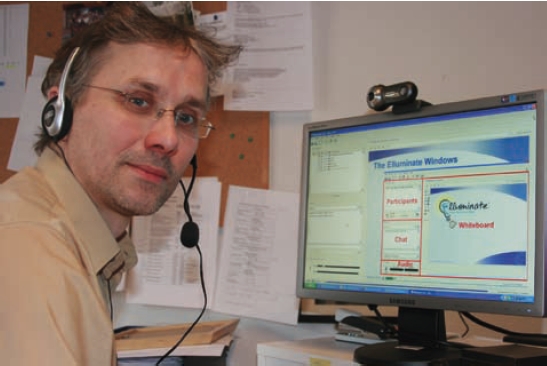
A teacher communicating with his distance students in the Virtual Classroom.
Communication with secretariat and lecturing staff has to be well organised.
It is an important aspect to create and maintain a good relation and stay
motivated for the course. Students in online courses depend completely on the
online communication.
Instructors and teaching staff must be up to date and aware of the
technologies used in e-learning. They will often find that students are ahead of
them in technological awareness and can learn from both formalized training and
interaction with students. The preparation of e-learning materials is time
consuming but can be rewarding with quality materials being produced and
motivated students getting involved. The interaction among students and between
students and faculty lead to continued faculty learning and awareness about
e-learning.
As with most successful undertakings, there must be an institutional “buy in”
to e-learning, whether it is produced by academia, government or private
business. There must be a commitment to invest in the technology – computers,
Internet, etc. – needed to make e-learning effective and successful.
4.2 Business models
Hoppe and Breitner (2003) define three types of business models for
e-learning. The “market” model defines the players and the market structure. The
“activity” model focuses on the activities of a business. The “asset” model
looks at costs and revenue.
Market based e-learning is based on supply and demand. Used by educational
institutions, it uses e-learning integrated into traditional course offerings as
well as for continuous learning for professional qualification. However,
e-learning is used in business as much or more as in academia. With this model
the student typically pays for education, or it is provided through the state,
through the normal fee structures of learning.
Activity based e-learning is related to customer needs. The learning is often
based upon one or more specific business products, usually software. The
learning may be provided directly from the business or through a service
provider. Depending on the complexity of the material, the demand for the
training and the willingness of students to pay for the learning, students may
or may not pay for the education. ESRI e-learning fits this model.
Asset based e-learning is used by academic institutions and by private
businesses. Again, academic institutions may have all or a part of the costs of
providing the education subsidized by the state. Students pay directly for the
e-learning content independent of other educational costs. Academic institutions
may themselves be the users of the content, either for in-house use or to pass
on to students. Payment may be by the course or by periodic membership fees.
Business factors driving the business models are various. Along with
traditional university degree programs, there are continuing education demands
that are being met through e-learning. Learning organizations, including
universities, are offering nondegree certifications on topic areas that enhance
employment qualifications. They provide coursework required by regulations on
continuing professional development. And they provide ongoing training on new
equipment and software (Barron, 2002).
Business models for academic programs can vary widely. An e-learning
consortium model is used by several universities in Europe. Each university
contributes one or more e-learning courses to a pool of courses. For each course
contributed, the university gains access to a certain number of courses from
other universities. Each e-learning course is developed from existing courses at
the university. The university delivers the full course to other universities
including instructor time (Blok, 2008; Markus, 2006).
4.3 Benefits
Perhaps the greatest benefit of e-learning is shown in the recent U.S.
Department of Education publication „Evaluation of Evidence-Based Practices in
Online Learning: A Meta-Analysis and Review of Online Learning Studies” (Means
et al, 2009). This study looked at various empirical studies done on e-learning
between 1996 and 2008 and concluded that students using e-learning performed
better than students who did not use e-learning. The students who performed best
were those who received blended learning. The studies were primarily performed
in higher learning environments such as professional education.
Other benefits fall into academic, economic, and social realms. Academic
benefits include increased access to knowledge through online resources, ease of
revision of course materials, ability of students to connect with experts around
the world, a more active role for learners in setting the pace of their
learning, more flexibility for both instructors and students, and scalability of
courses from small to large numbers of students simultaneously (Lam 2008,
Mansberger et al, 2006, 2008; Markus, 2006).
Economic benefits can include the ability to expand student enrolment,
reduction of student travel, ease of revision of course materials and reduction
of teaching facilities (Mansberger et al, 2006; Olaniyi, 2006).
Social benefits are mixed. While it can be more difficult to motivate
students when using e-learning (Bjorke, 2008), students who can self-motivate
have a more direct control over their individual learning (Olaniyi, 2006).
5. Role of e-learning in surveying
5.1 Awareness building
Within the last decades the introduction of computers has changed rapidly the
society, science and technology around the surveying profession (Markus, 2008).
Changes took place in the field of data collection, data storage, data
processing and visualisation. New technologies appeared, which – 20 years ago –
were not known by most of the surveyors and other professionals involved in
spatial data capture, like GNSS (Global Navigation Satellite Systems), GIS
(Geographic Information Systems), Laser Scanning, Digital Photogrammetry or Web
Technologies. These new technologies require additional technical knowledge.
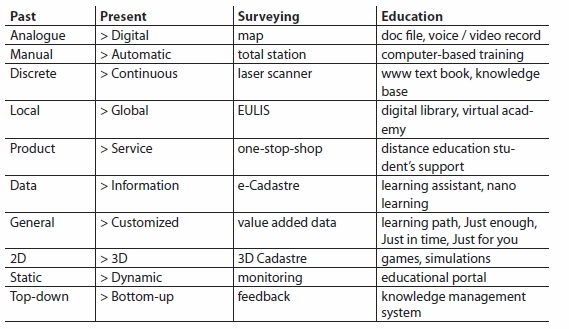
Table 1: Technological trends and changes in surveying and education due
to introduction of computers.
In a global perspective the role of surveyors is also shifting: Enemark
(2009) entitles the change as the big swing “From Measurement to Management” in
the sense that surveyors have extended their technical knowledge by social,
legal, economic and environmental understanding.
The new professional fields require a change in the professional education
and training. A new kind of knowledge is needed. Enterprises and professional
institutions expect Employability from the alumni of academic studies:
that means subject specific basic knowledge, professional technical and
methodological competence as well as generic competences and skills, like the
ability to communicate, the capacity for teamwork, the learning aptitude and the
capability for analysis.
Besides the new requirements from a professional point of view the academic
surveying education nowadays is affected by additional determining factors:
Globalisation, demographic development, and new public management:
Table 1: Technological trends and changes in surveying and education due to
introduction of computers.
- Globalisation will force academic institutions to cooperate, to
exchange staff members and students, but also to sharpen their individual
profiles to prove in the national and international competition.
- In the next 40 years worldwide the population will increase
approximately by 30 percent. But the detailed figures show a sharp contrast
in the democratic development between countries. In some regions
(especially in Europe) the population is decreasing (UN, 2008). Both
developments are a challenge for educational aspects.
- Within the last years at many (especially European) universities new
public management was implemented. The benefit of an increased
flexibility of financial resources and of the self-reliance in human
resource management is accompanied by additional administrative duties and
tasks for staff members (Mansberger et al., 2006).
Educational institutions in general and academic surveying organisations in
particular have to meet the outlined changes, frame conditions new challenges. A
paradigm shift in academic education is required:
- From teaching to learning:
Education has to focus on students, to learning processes and to learning
outcomes. Traditional, subject-orientated teaching has to be substituted by
individual project-orientated and self-organised learning. Teachers have to
change their role from presenters and instructors to facilitators, mentors,
tutors, coaches, and consulters (Wildt, 2008).
- From timed and on-site lectures to time and site independent
education:
Modern educational methods enable self-paced and self-directed learning with
a high flexibility on time and site. So learning materials and most of the
support has to be available 24 hours / 7 days (Markus, 2006).
- From self-contained studies to life-long-learning:
The increase of worldwide knowledge is estimated to be doubled within four
years. Therefore the existing concept of self-contained study courses has to
be replaced by the concept of continuing professional development.
E-learning is a proper facilitator to manage this paradigm shift in academic
education as shown in a (modified) list of the most important features of
e-learning outlined by Markus (2006):
- E-learning services designed using learner-centred approaches.
- E-learning gives learners a chance to speed up or slow down as needed.
- E-learning can happen when needed. It enables a high flexibility on time
and site for teachers and students.
- E-learning does not require physical presence.
- E-learning promotes greater student interaction and advances
collaboration.
- E-learning uses interactive technology to develop fun, engaging,
effective simulations.
- E-learning opens global opportunities.
But nevertheless all proponents of this modern teaching and learning
technologies have to be aware that
- E-learning is just a tool and Learning is the objective. Powerpoints and
scripts to download on the internet are not e-learning. Pedagogy must take
the lead, while technology responds to the pedagogical training (Bjørke,
2008).
- E-learning does not save time for the teachers – but it improves the
knowledge transfer.
- Virtual communication cannot completely substitute personal
communication (Mansberger et al., 2008).
The introduction of e-learning requires accompanying measures. Teachers have
to acquire new competences: Information and Communication Technologies (ICT) as
well as e-pedagogy are needed ingredients for operating e-learning. In this
point surveyors are favoured as they are very familiar and skilled in working
with ICT.
Institutions dealing with surveying education also have to redesign the
curricula: Subjects, contents and learning methods have to be adapted to
e-learning to meet the demands of employability.
And finally, high priority must be given to the introduction of a quality
assurance system to guarantee the high level of academic surveying education.
The urgency of this requirement is enhanced by the increased time-independency
as well as site-independency of students and lecturers due to international
mobility programs and the availability of new electronic teaching tools
(Mansberger et al., 2006).
5.2 Platform for collaboration
In the early days of e-learning discussions were dominated by content. The
content still remains a constant factor in e-learning, but with the introduction
of Web 2.0 technologies to the higher education the focus shifted towards online
communication and collaboration (O’Reilly, 2006).
The modern forms of ICT – also called social software – are appropriate
facilitators for implementing the metamorphosis from “teaching” to “learning”.
Communication tools in e-learning are platforms for collaboration for all actors
involved in professional educational (e.g. teachers, learners, experts,
facilitators, mentors, supervisors, coaches) and they enable mutual learning in
different appearances:
- between peers or between persons with different educational status
- between practice and academic
- bidirectional or in groups
- synchronous or asynchronous
- cross-functional or cross-sectional
- in a local or global level
- formal or informal.
5.3 Sharing good practice
Workshops and conferences organised by FIG Commission 2 (Professions
Education) have identified a large evidence of e-learning projects and a high
level of acquired experience within the academic surveying community. The topics
for Lessons Learnt in the field of e-learning are manifold and cover
educational, didactical, pedagogical issues, but also technical and economical
aspects. Experiences of experts in surveying education with e-learning and
developments of practical e-learning materials are published in the proceedings
of above mentioned conferences (FIG, 2006; FIG, 2007; FIG, 2008; FIG, 2009).
It is the order of the day to share this knowledge within the professional
community to enable an improvement of academic surveying education on a global
level. Demandorientated education outlined by modern and up-to-date learning
technologies is the best promotion for the surveying profession and a conditio
sine qua non for the recruitment of students.
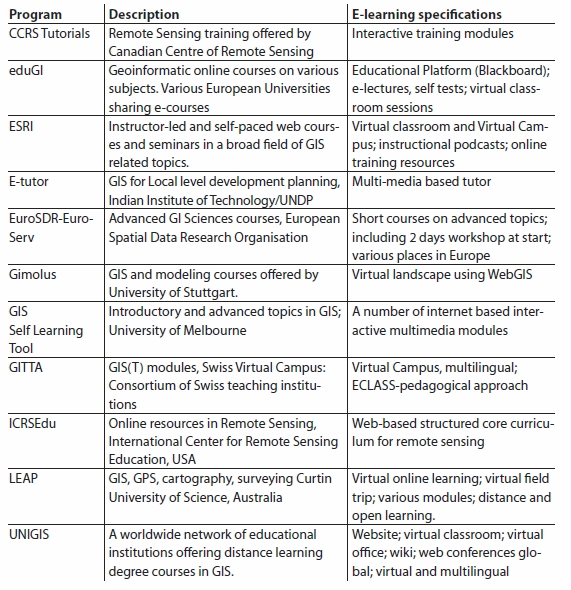
Table 2: Overview of major online distance programs offered in the field
of surveying, geo-information science and remote sensing.
5.4 Creating a learning community
E-learning is an important driving force for the implementation of up-to-date
learning activities. Technology-enhanced learning also opens global classrooms:
e-learning is a catalyser for collaboration across national and international
boundaries as well as a facilitator for worldwide networks of academic learning
communities. These networks facilitate the development of high quality courses
and study programmes ensuring currency, relevance and a broad curriculum
catalogue (Bjørke, 2008).
Working together, sharing of experiences and resources, is considered of
great importance for the success and further development of e-learning in the
field of surveying, geo-information science and land administration
(Groenendijk, 2008). New national and international partnerships between
academics and professionals have to be established with the objective to share
knowledge in the development of staff, in the development of learning contents,
in the development of pedagogic concepts, and in the development of business
models.
But all the activities and efforts of creating international learning
communities have to take into consideration the regional requirements of
learning outcomes, the cultural differences in learning style and content, and
the language barriers. From a technical point of view the limiting factors of
e-learning are the access to computers and the internet penetration within a
region or a country.
5.5 The growing importance of
life-long-learning
The current increase and improvement of technologies and methods and the new
needs of employability in the field of surveying profession necessitates a
continuous knowledge gain surveying experts. University graduation is no longer
a ticket for professional career. Learning for life has to be shifted to
life-long learning (Enemark, 2009) to meet the challenges of this accelerated
change of requirements for profession. Additionally, the need for more flexible
learning paths will keep growing in the future to react to the ever-faster
changing needs of the labour markets, to the demographic developments and to the
more mobile workforce (Bacher, 2009).
Academic surveying institutions have to provide life-long-learning.
University studies and traditional professional education have to be adapted,
have to be extended by (part-time) training programmes and have to be integrated
to a system of Continuous Professional Development (CPD).
6. FIG policy on e-learning
It is amongst the objectives of FIG Commission 2 (Professional Education)
- to support academic institutions and industry with new methods of
knowledge management, helping surveyors continuously to update their
academic and professional profiles
- to promote content development experiences, facilitating international
researches in surveying education and training and to initiate joint
projects on this field (curriculum development, educational material
development, joint courses, quality assurance etc.)
- to strengthen knowledge transfer between FIG Commissions, inspiring
activities on knowledge networks and
- to improving dissemination of information on educational theory and
practice to the members across the world.
FIG has recognised e-learning as a proper tool to realise the above outlined
objectives. Therefore appropriate strategies were discussed within
FIG-Commission 2 to promote the use of e-learning in the surveying community and
to encourage academic, professional and governmental institutions to use this
cutting edge learning technology. This can be achieved by the following
activities:
- FIG will stimulate e-learning by raising the awareness about the
paradigm shift in education from teaching to learning, by communicating
employability and life-long-learning as the new requirements for an
up-to-date academic professional education, and by incentivising teaching
staff (e.g. FIG award for e-learning).
- FIG will distribute information on the topic of e-learning to the
surveying community, e.g. by publishing conference papers, by this booklet
on e-learning, by compiling a reference book about e-learning or by a
register of “good practice”.
- FIG will bring experts together to share their knowledge on the
topic of e-learning. This can be done physically during conferences or
workshops or virtually in form of electronic discussion forums.
- FIG promotes e-learning networks starting with FIG Commission 2
as a seed. But FIG will also increase cooperation on the topic of e-learning
with other organisations in the field of geosciences, like ISPRS and ICA.
- FIG will encourage their members to develop and share e-learning
contents within surveying education. This can be achieved by the
establishment of a database with specific learning materials, such as
literature, scripts, interactive learning tools, test questions, etc; and
through development of a quality assessment guide for e-learning courses.
- FIG will influence and encourage governmental and administrative
bodies to support the introduction of e-learning and life-long-learning
as well as to provide the political frame conditions to enhance these
activities.
- Ajjan, H. and R. Hartshorne (2008). Investigating faculty decisions to
adopt Web 2.0 technologies: Theory and empirical tests. Internet and Higher
Education 11, 71–80.
- Australian Flexible Learning Community (2002). Retrieved June 5,2009,
from:
http://community.flexiblelearning.net.au/TechnologiesforLearning/content/article_442.htm.
- Bacher, G. (2009). The European Higher Education Area: Goals Achieve &
Outlook towards 2010 and Beyond. FIG Workshop on Navigation the Future of
Surveying Education, Vienna, Austria.
- Barron, T. (2002). Evolving Business Models in eLearning. Summary white
paper: Learning on Demand. Retreived June 30, 2009, from
http://www.sric-bi.com/LoD/summaries/EvolvBizModelsSum.pdf.
- Beck, R. J. (2007) What are learning objects? Retrieved December 25,
2009, from:
http://www4.uwm.edu/cie/learning_objects.cfm?gid=56.
- Bjorke, S. A. (2008). Challenges and training needs of E-supporters.
Sharing Good Practices: E-learning in Surveying, geo-information Sciences
and Land Administration. FIG International Workshop, Enschede, Netherlands,
11–13 June, 2008.
- Blok, C. A. (2008). Sharing e-courses in GI science with partners:
business model, experiences, and lessons learnt. Sharing Good Practices:
E-learning in Surveying, geoinformation Sciences and Land Administration.
FIG International Workshop, Enschede, Netherlands, 11–13 June, 2008.
- Cepek, A. and J. Pytel (2006). Collaborative Academy. FIG Workshop on
eGovernance, Knowledge Management and e-learning. Budapest, Hungary, 2006.
- Chiappe, A. et al., 2007: “Toward an instructional design model based on
learning objects”, in Educational Technology Research and Development,
Springer, Boston, pp. 671–681.
- Enemark, S. (2007). Promoting the interaction between education,
research and professional practice. Proceedings FIG Commission 2 –
Symposium, Scientia est Potentia – Knowledge is Power, 7–9 June 2007, Czech
Technical University, Prague, Czech Republic.
- Enemark, S., 2009: Surveying Education: Facing the Challenges of the
Future, FIG Workshop on Navigation the Future of Surveying Education,
Vienna, Austria.
- Fairlie, K. (2009). Navigating the global consciousness: a young
surveyor’s future. Proceedings FIG Working Week, Surveyors key role in
accelerated development, 3–8 May 2009, Eilat, Israel.
- FIG (1996). FIG Publication no. 15. CPD – Continuing Professional
Development and its future promotion within.
- FIG (2006) Workshop on eGovernance, Knowledge Management and e-learning;
Proceedings. Editor: Bela Markus. Published by College of Geoinformation.
University of Hungary. April 2006. Budapest. Hungary.
- FIG (2007). Scientia Est Potentia; Jubilee Proceedings. Editor: Aleš
Čepek. Published by the Czech Technical University in Prague. June 2007.
Prague. Czech Republic.
- FIG (2008). FIG International Workshop. Sharing Good Practices:
E-learning in Surveying, Geo-Information Sciences and Land Administration.
Proceedings. Editors: Liza Groenendijk, Christian Lemmen. Published by
International Institute for Geo-Information Science and Earth Observation
(ITC). June 2008. Enschede, the Netherlands.
- FIG (2009). FIG Workshop on Navigation the Future of Surveying
Education. Proceedings. Editor: Austrian Society of Surveying and
Geoinformation. Österreichische Zeitschrift für Vermessung und
Geoinformation (vgi). 97.Jahrgang, Heft 1/2009. Vienna, Austria.
- Groenendijk, E. M. C. (2009). “Experience-based learning and e-learning:
a perfect combination.” International Archives of Photogrammetry, Remote
Sensing and Spatial Information Sciences 38(6/W7).
- Groenendijk, E.M.C. (2009). Experience-based learning in the
geo-information sciences: 15 years of nuts game. Proceedings FIG
International workshop, Navigating the future of surveying education, 26–28
February 2009, Vienna, Austria.
- Groenendijk, E.M.C. (2008) Sharing Good Practices in E-Leaning: outcome
of a workshop. FIG International Workshop Sharing Good Practices: E-learning
in Surveying, Geoinformation Sciences and Land Administration. Enschede,
Netherlands.
- Hodgins, W. and M. Connor (2000). Everything you wanted to know about
learning standards but were afraid to ask. Line Zine, Fall 2000. Online
version. Retrieved June 5, 2009, from
http://www.learnativity.com/standards.html.
- Hoppe, G. and M. H. Breitner (2003). Business Models for E-learning.
University of Hannover, Discussion paper 287. Retrived from June 1, 2009,
from:
http://www.wiwi.uni-hannover.de/Forschung/Diskussionspapiere/dp-287.pdf.
- Kottyan, L. (2006). Open systems in e-learning. In: Proceedings FIG
Workshop eGovernance, Knowledge Management and eLearning, 27–29 April 2006,
Budapest, Hungary.
- Kottyan, L. (2008). Sharing student knowledge in exchange programs. In:
Proceedings FIG International Workshop. Sharing Good Practices: E-learning
in Surveying, Geoinformation Sciences and Land Administration, 11–13 June
2008, ITC, Enschede, the Netherlands.
- Lam, S. Y. W. (2008). Blended e-learning Model for Geomatics Curriculum:
Design, Implementation and Evaluation. Proceedings of FIG Commission 2
Workshop, Sharing Good Practices: E-learning in Surveying, Geo-information
Sciences and Land Administration, 11–13 June, 2008, Enschede, Netherlands.
- Lam, S. Y. W. (2008). Blended e-learning Model for Geomatics Curriculum:
Design, Implementation and Evaluation. Proceedings of FIG Commission 2
Workshop, Sharing Good Practices: E-learning in Surveying, Geo-information
Sciences and Land Administration, 11–13 June, 2008, Enschede, Netherlands.
- Learning organization (2009). Retreived 8 Aug 2009, from:
http://en.wikipedia.org/wiki/Learning_organization.
- Macromedia (ND). E-learning Standards. Online document. Retrieved June
5, 2009, from
http://www.adobe.com/resources/elearning/standards.html.
- Mahoney R., F. Plimmer, J. Hannah and J. Kavanagh (2007). Where are we
heading? The crisis in surveying education and a changing profession.
Proceedings FIG Working Week 2007, Strategic Integration of Surveying
Services, 13–17 May 2007, Hong Kong, China,
- Mansberger, R., C. R. Michalek, and T. Bauer (2008). Communication Tools
in E-learning: Experiences in Academic Geomatics Education, Sharing Good
Practices: E-learning in Surveying, Geo-information Sciences and Land
Administration, FIG International Workshop, Enschede, the Netherlands, 11–13
June 2008.
- Mansberger, R., H. Schuh, G. Steinkellner (2006). Impacts of the Bologna
Process and of New Public Management on the Academic Surveying Education in
Austria. XXIII International FIG Congress, International Federation of
Surveyors.
- Mansberger, R., T. Bauer and E. Heine (2006). Flop or Top – Experiences
with E-learning in Academic Education. FIG Workshop on eGovernance,
Knowledge Management and eLearning, Budapest, Hungary, 2006.
- Markus B. (2000): Educational metadata, FIG Working Week, Prague, Czech
Republic.
- Markus B. (2002). (Global) spatial knowledge management, GSDI 6
Conference – From global to local, Budapest, Hungary.
- Markus, B. (2006). Experiences in and Around e-learning. Proceedings
XXIII FIG Congress, Shaping the Change, 8–13 October, 2006, Munich, Germany.
- Markus, B. (2008). Thinking about e-learning. Proceedings FIG
International Workshop. Sharing Good Practices: E-learning in Surveying,
Geo-information Sciences and Land Administration, 11–13 June 2008, ITC,
Enschede, the Netherlands.
- Means, B., Y. Toyama, R. Murphy, M. Bakia and K. Jones (2009).
Evaluation of Evidence-Based Practices in Online Learning: A Meta-Analysis
and Review of Online Learning Studies. U.S. Department of Education, Center
for Technology in Learning, May 2009.
- Milenov, P. and S. Kay (2008). Provision of technical support and
regulatory reference information on the control of agricultural subsidies in
EU through use of Wiki-based Knowledge Management. Sharing Good Practices:
E-learning in Surveying, geo-information Sciences and Land Administration.
FIG International Workshop, Enschede, the Netherlands, 11–13 June, 2008.
- Molendijk, A. M., H.J. Scholten & J. Kaandorp (2008). Geographical
Information for all: Breaking the Barriers for GI Distance Learning. In:
Proceedings FIG International Workshop. Sharing Good Practices: E-learning
in Surveying, Geo-information Sciences and Land Administration, 11–13 June
2008, ITC, Enschede, the Netherlands.
- O’Hear, S. (2006). How E-learning 2.0 – How Web technologies are shaping
education. ReadWriteWeb. Retrieved June 1, 2009, from:
http://www.readwriteweb.com/archives/e-learning_20.php.
- Olaniyi, S. S. (2006). E_learning Technology: The Nigeria Experience.
Shaping the Change: XXIII FIG Congress, Munich, Germany, October 8–13, 2006.
- O’Reilly, T., 2006:
http://radar.oreilly.com/archives/2006/12/web-20-compact-definitiontryi.html,
last visited: 12 April 2008.
- Osskó, A. (2008). The importance of changes in land surveyors’
education. Proceedings FIG International Workshop. Sharing Good Practices:
E-learning in Surveying, Geo-information Sciences and Land Administration,
11–13 June 2008, ITC, Enschede, the Netherlands.
- Pasternack, P., R. Bloch, C. Gellert, M. Hölscher, R. Kreckel, D. Lewin,
I. Lischka, A. Schildberg (2009). Die Trends der Hochschulbildung und ihre
Konsequenzen. HoF Wittenberg – Institut für Hochschulforschung an der
Martin-Luther-Universität Halle-Wittenberg. Bundesministerium für Bildung,
Wissenschaft und Kultur (BMBWK). Wien. Retrieved September 29, 2009, from:
http://www.bmwf.gv.at/uploads/tx_bmwfcontent/studie_trends_hsbildung.pdf.
- Petch, J. (2006). All things „e”: understanding the real challenges in
an accelerating world. FIG Workshop on eGovernance, Knowledge Management and
e-learning. Budapest, Hungary, 2006.
- Polsani, P. (2003). Use and Abuse of Learning Objects. Journal of
digital information. Vol 3, Issue 4, Article No. 164, 2003-02-19. Online
version. Retrieved June 5, 2009
- SCORM (2004). SCORM Explained. Online document. Retrieved June 5, 2009,
from:
http://www.scorm.com/scorm-explained/.
- Todorovski, D. (2008). Capacities, tools and methods that support
E-learning. Sharing Good Practices: E-learning in Surveying, geo-information
Sciences and Land Administration. FIG International Workshop, Enschede,
Netherlands, 11–13 June, 2008.
- UN, 2008: United Nations Department of Economic and Social Affairs.
World Population Prospects: The 2008 Revision. Retrieved September 22, 2009,
from:
http://www.un.org/esa/population/publications/wpp2008/wpp2008_highlights.pdf.
- Verkroost, M. J. (2009). From multi-usable courseware to a multi-usable
pedagogy. In: Proceedings ISPRS Workshop Commission VI/2 V12, E-learning
Tools, Techniques and Applications, 17–19 June, 2009, Potsdam, Germany.
- Wahlstrom, D. A. (2008). Distance Education Using Contemporary
Technology. Sharing Good Practices: E-learning in Surveying, geo-information
Sciences and Land Administration. FIG International Workshop, Enschede,
Netherlands, 11–13 June, 2008.
- Wildt, J. (2008). Reader “Lehren und Lernen”. Manuscript of the Course
on Didactic 2008/09 at the BOKU-University of Natural Resources and Applied
Life Sciences Vienna. Centre for Research on Higher Education and Faculty
Development of the University of Technology Dortmund. 2009.
- Wiley, D. A. (2000). Connecting learning objects to instructional design
theory: A definition, a metaphor, and a taxonomy. In D. A. Wiley (Ed.), The
Instructional Use of Learning Objects. Retrieved June 1, 2009, from:
http://reusability.org/read/chapters/wiley.doc.
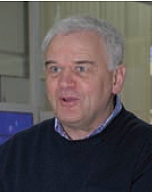
Dr. James Petch
Telaman Ltd, Manchester and
University of Manchester
|

Dr.
Adrijana Car
UNIGIS Salzburg at Centre for Geoinformatics, University of Salzburg and
UNIGIS International Association |
The UNIGIS network of universities has provided postgraduate distance
learning in Geographic Information Science and Technology (GISc&T) since the
early 1990s (Molendijk and Scholten, 2006) based on a model developed in the UK
in 1988–89. It has grown from a UK partnership, to a European consortium into a
global network offering different types of academic programmes and
qualifications in several languages to students with a wide range of backgrounds
(http://www.unigis.net/).
This success is based on two sets of factors related first to the setting up
and secondly to the sustaining of a programme of learning which has continued to
meet a vigorous market demand. These factors provide insights into good practice
for all aspects of such distance learning provision and they may hold lessons
for other programmes.
From the outset UNIGIS was conceived as cooperation between institutions
which could benefit from the sharing of resources and expertise and who by
committing to a common purpose could each achieve success in reaching a growing
market that alone they could never aspire to. Additionally cooperation was seen
as a fast track and a sustained track to innovation and continuing progress in a
rapidly changing field. Thus a prime building bock of the collaboration has been
a contract that sets out these aims and principles in a transparent manner.
Everyone has a stake in the collaboration and clear benefits. Having such a
contract has ensured recruitment to the network and ensured continuing
commitment and inputs to the common cause.
A further factor for success has been the careful selection and grooming of
potential partners and a corresponding clear commitment to continuing support
once they are members. The UNIGIS network didn’t aim to recruit the most famous
names or the biggest GI operations. Size didn’t matter. What mattered were
ambition, a willingness to share and cooperate and a commitment to stay on
course. Potential members had to show that being a member would make a
difference to them and that being part of UNIGIS was part of their strategy.
Sustained resourcing and maintained objectives were an essential criterion for
membership. Joining UNIGIS had to be an institutional commitment.
A major benefit for joining UNIGIS, that was a conscious part of agreements,
was being able to plug in immediately to a mature, quality assured course with
proven processes and instruments for administration, design and development.
This strategy has in fact brought other benefits. As new members join they bring
their own good practices and enrich the understanding of the wider group as to
what works well and what does not. With an active, involved community there is a
constant development of all aspects of the course and this is reflected in a
strengthening array of practices. The lesson here is that usage and challenging
of practices makes for improvement. But, the prerequisite is the adoption of
common practices in a trusting group.
Many other aspects of the UNGIS experience show the importance of sustaining
good practice, which means renewal and constant improvement. This focus on
quality has many facets (Strobl and Car 2009).
Clearly defined professional qualifications
Credible qualifications and their acceptance depend on a number of factors,
especially:
- curriculum and syllabus
- professional relevance and employability
- track record with alumni and in industry
- formal accreditation and quality indicators.
With UNIGIS programmes primarily taken in part-time in-service mode by
professionals already active in the field of GIS&T, learning is directly coupled
with professional practice. Employers have and express clear expectations and
learners already know from on-the-job experience about their strengths and
weaknesses, and thus about deficits to be compensated and gaps to be filled.
In-service programmes therefore undergo constant practical checks of relevance,
and receive immediate feedback regarding topical priorities and curricular
completeness.
Additionally, students are sensitized to topics currently dealt with in their
study programme, and to recognize issues in their professional practice which
otherwise would have gone unnoticed. This kind of awareness building is a core
objective of advanced courses; seeing problems often is a more critically
important qualification than solving them.
Reputation is a critical factor in sustaining success, whether in education
or other knowledge-centric activities. A documented and evident track record, as
well as word of mouth recommendations, of delivering what has been promised, of
fulfilling the personal and professional objectives of students, and above all
of advancing the professional capabilities and careers of alumni are important
factors in attracting and convincing future applicants to pursue a particular
education track.
The UNIGIS programme has spawned a number of informal communities of practice
and institutionalized a loosely knit alumni network (‚Club UNIGIS‘) based on its
strength of not having a clearly defined operational mission. Rather, this
network, like other groups in UNIGIS autonomously collaborates on a broad range
of topics from simple (to rather complex) technical support to information about
job offerings, jointly tackling more complex projects or looking for particular
expertise on a given subject. There is a lot of giving and taking across this
network, recently most valuable professionals (MVPs) were identified by their
generous contributions through sharing advice and offering support. All this
works without an organisational framework or institutional infrastructure,
demonstrating the power and effectiveness of online communities sharing a common
purpose.
For the entire UNIGIS network, a common core curriculum is a key constituting
element, a strong common denominator binding programmes in a variety of
languages, institutional and legal frameworks and variants in their mode of
delivery together. In a continuously evolving environment like GISc&T, a
curriculum cannot be considered as being set in stone, it rather has to adjust
to innovation, demands from professional practice, and an expanding set of
application domains. Rapid change, though, would create confusion and
organisational challenges, and unstable expectations regarding educational
outcomes. Therefore managing curricular change is an ‚art‘ of balancing adaption
and innovation with a certain level of stability and continuity.
Curriculum development is a major ‚export article‘ of UNIGIS, as partners in
the network have been and still are involved in curriculum development projects
around the world (see e.g. Car and Strobl 2007;
http://tempus.geoinfo.geof.hr/).
Typically conducted as consortia projects in particular regions, and frequently
co-funded by European Commission programmes, new curricula (plus their
implementation) are set up at institutions launching or enhancing education in
GISc&T.
The distance learning / eLearning / online learning mode of delivery clearly
is the key factor why prospective students choose this type of programme. Over
several years it has become increasingly evident that there is no
one-size-fits-all model for organisation and delivery of postgraduate
qualifications in GISc&T (Howell et al 2003). Full distance learning serves
part-time students well while there is a growing demand for ‚going back to
school‘ for a condensed full-time study experience (which might be split over
several periods) or even entering postgraduate online learning immediately after
undergraduate studies.
The organisation and communication concept behind a distance education offer
clearly is a core success factor determining the long term sustainability of
programmes like UNIGIS (Molendijk et al 2008). Several aspects of the concept
which underpin continued attraction of UNGIS course are:
- combination of advantages of centralized course delivery with regional
access to support
- leveraging of novel Internet-based communication facilities to really‚
stay in touch
- balancing an accepted core set of knowledge and skills with flexible
options to enable individual choices of elective subjects.
While distance learning clearly is important, it is not a value per se. It is
valuable, if it enhances the accessibility of continuing education for a target
group of learners. The actual issue therefore is catering to the needs of a
mature, well motivated and professionally active community of learners who are
less mobile due to their job locations as well as social commitments. Bridging
distances, and facilitating communication by online media is a very helpful
element in allowing access to continuing education.
International differences in educational systems, cultural expectations,
online access and levels of prior learning are significant. Maintaining a common
standard of across qualification systems in different countries turns out to be
an impossible objective and likely will be a challenge forever. Nevertheless,
the professional commonality between North America and Central Asia, between
Europe, Latin America and the Indian subcontinent is greater than it might be
expected, not the least due to the unifying and ‚standardizing‘ force of a
global software industry and common issues in professional practice.
Quality Assurance is a permanent challenge in a distributed set of programmes
being taught across all boundaries of cultures, languages, professions and
levels of economic development (ENQA 2005). UNIGIS (Car 2008) has therefore
implemented a clearly defined framework of goals, tools and indicators
facilitating the integrity, monitoring and continuous improvement of academic
programmes. These start from a common core curriculum referenced to established
benchmarks, standards for teaching and performance assessment, and
cross-programme checks like joint degrees, credit transfer options and mutual
evaluations.
- Car, A. (2008). Towards a Quality Assurance Concept for Postgraduate
Distance Learning Programmes for Professionals. Lernen mit Geoinformation
II. T. Jekel, A. Koller and J. Strobl. Heidelberg, Wichmann: 172–178.
- Car, A and J. Strobl (2007): TEMPUS: GISc&T Position and Role in
Croatian Higher Education, [Online], available:
http://vector1media.com/article/feature/tempus-%3agisc%26t-position-and-role-in-croatian-higher-education/,
accessed on February 4, 2009.
- DiBiase, D., DeMers, M., Johnson, A., Kemp, K., Luck, A.T., Plewe, B.,
and Wentz, E. (2006). Geographic Information Science & Technology Body of
Knowledge, Washington, D.C.: Association of American Geographers.
- ENQA. (2005). Standards and Guidelines for Quality Assurance in the
European Higher Education Area. Bergen Report. European Association for
Quality Assurance in Higher Education (ENQA) published on. Accessed from
http://www.enqa.eu/files/ENQA%20Bergen%20Report.pdf, accessed on
February 4, 2009.
- Howell, S. L., P. B. Williams and N. K. Lindsay (2003). Thirty-two
Trends Affecting Distance Education: An Informed Foundation for Strategic
Planning [online]. Online Journal of Distance Learning Administration. State
University of West Georgia, Distance Education Center VI(III, Fall 2003).
http://www.westga.edu/~distance/ojdla/fall63/howell63.html, accessed on
February 4, 2009.
- IHEP (2000). Quality on the Line: Benchmarks for Success in
Internet-Based Distance Education. The Institute for Higher Education
Policy, Washington DC published on April 2000. Accessed from
http://www2.nea.org/he/abouthe/images/Quality.pdf, accessed on February
4, 2009.
- Finnie, R. and Usher A. (2005). Measuring the Quality of Post-secondary
Education: Concepts, Current Practices and a Strategic Plan. Canadian Policy
Research Networks Inc. (CPRN).Research Report W|28,
http://www.cprn.com/doc.cfm?doc=1208&l=en, accessed on February 4, 2009.
- Molendijk, M.A. & Scholten, H.J. (2006). From Local Heroes towards
Global Communicators: the Experience of the UNIGIS network in educating GIS
Professionals Worldwide. In Nuffic Expert Meeting. Den Haag: NUFFIC.
- Molendijk, M.A., Scholten, H.J. & Kaandorp, J. (2008). Geographical
Information for all: breaking the barriers for GI distance learning. In L.
Groenendijk & C. Lemmen (Eds.), Proceedings FIG International Workshop 2008:
Sharing Good Practices: E-learning in Surveying, Geo-information Sciences
and Land Administration (pp. 85–100). Enschede: FIG International.
- Strobl, J. (2008): Digital Earth Brainware. A Framework for Education
and Qualification Requirements. In: Schiewe, J. & Michel, U. (Hrsg., 2008):
Geoinformatics paves the Highway to Digital Earth. gi-reports@igf,
Universität Osnabrück, pp. 134–138.
- Strobl, J. and A. Car (2009). Continuing Professional Education via
Distance Learning – Success Factors and Challenges. FIG International
Workshop Vienna 2009 “Navigating the Future of Surveying Education”, Vienna,
Austria. The FIG Commission 2 and the Austrian Society for Surveying and
Geoinformation (OVG).
|
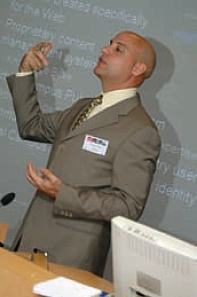
Nicholas Frunzi, ESRI
Nicolas Frunzi delivering his key note speech at the Commission Workshop
in Enschede, the Netherlands. |
The Virtual Campus is ESRI’s e-learning solution, providing a platform
for both synchronous and asynchronous online courseware. First launched in
July of 1997, for the past 12 years the Virtual Campus has supported an
average of 10,000 students per month, totaling over half a million students.
In 2001, ESRI partnered with the authors of Geographic Information Systems
and Science (GIS&S) to produce a hybrid e-learning course offering, entitled
Turning Data into Information Using ArcGIS 8. The course was designed to
complement the GIS&S book and reinforce its concepts through exercises and
examples. Although the book was no a requirement for course completion, when
combined, the two provide a well-rounded pairing of academic and practical
instruction. When the book was updated to a second edition in 2004, the course
was updated to use ArcGIS 9. Since its introduction, over 5,100 students have
taken this e-learning class, and as such, ESRI views the collaboration with the
authors as a success, and is dedicated to continuing the relationship with the
author team. The course will soon be updated to complement the forthcoming third
edition of the book.
Additionally in 2001, ESRI decided it was time to offer a synchronous
e-learning product, known as Live Training Seminars. A Live Training Seminar
(LTS) is one hour of free synchronous content featuring an instructor lecturing
with PowerPoint presentations or demonstrations through the Virtual Campus.
Interactivity is achieved via a virtual chat, where the students post questions.
At intervals throughout the hour, the instructor will answer, via voice, the
questions that were posed via chat. An assistant in the room collects the
questions for the instructor. Currently, ESRI provides LTSs approximately every
six weeks, three times during a given day at 9:00am, 11:00am and 3:00pm PST.
There are over 1,200 attendees on average, for each day ESRI offers the
sessions. This model uses a streaming media server and the only requirement from
the student’s perspective is a Windows Media plug-in on their computer and
Virtual Campus access. This model became a quick success and as such ESRI
developed a dedicated studio space for LTS production.
ESRI also built derivative works from the LTS. A Training Seminar (TS) is an
asynchronous version of an LTS. ESRI digitally records each LTS and then selects
the best presentation of the three and conducts a small amount of
post-processing to clean up the live event. The TS is then uploaded to the
Virtual Campus to be consumed by anyone at anytime for free. This model of
educational offering has grown beyond being simply a by-product of an LTS. ESRI
now creates TSs to teach important topics that do not necessarily need the added
value of a live instructor to interact with and answer questions.
A second derivative work was the Web Workshop (WW), which were implemented
between 2001 and 2005. Web Workshops differed from the LTS and TS by two
important characteristics. The Web Workshop was a “for fee” educational offering
derived from a TS. In this case, ESRI would create an exercise from a TS using
the software to allow the student to not only hear the lecture and see the
PowerPoint slides and demos, but to actually download the data and use the
software hands-on, to accomplish similar tasks as outlined in the TS. These Web
Workshops became very popular and useful in an on-demand learning environment,
allowing short focused topics and the ability for the student to actually use
the software. Over time ESRI also wanted to produce shorter courses in the
original format, so the WW model was eliminated to become one-module courses,
removing confusion and simplifying ESRI’s educational offerings.
In 2004, ESRI added another synchronous offering: the Instructor-led Virtual
Classroom (ILV). In this model, ESRI wanted to expand the success of the LTS and
WW into a larger event. ESRI decided on a total of nine hours of instruction
delivered over three days, three mornings or three afternoons. At this juncture
ESRI was very concerned with trying to provide eight hours of instruction in one
continuous day, online. There was a worry that the current delivery methods
would not keep a student’s attention for the extended time period. To mitigate
this concern, training was offered on Tuesday, Wednesday, and Thursday (mornings
or afternoons) of a given week. This allowed ESRI to manage any technical issues
with the students on the Monday before the class began. The ILV instructional
model was similar to the LTS in that there is a live instructor presenting
PowerPoint slides and demos. ESRI used
the existing LTS studio and media streaming equipment. Different than the LTS,
the ILV offered software exercises. Using a Citrix® virtual environment,
students were able to take training without having any impact on their
production environments. Importantly, it allowed the instructor to “shadow” the
student’s work if they needed assistance, by viewing their progress through
Citrix and even taking over the control of the machine as necessary to provide
further instruction or assistance. ILVs also introduced phone conferencing in
the virtual classrooms, allowing voice, instead of virtual text chat, so the
students would have access to speak to each other, the class, and the
instructor.
2005 brought the introduction of ESRI’s use of Sharable Content Object
Reference Model (SCORM). The SCORM specification is promoted by the US
Department of Defense as a standard e-learning specification allowing content to
be easily packaged and consumed by different Learning Management Systems (LMS).
This ability allows ESRI to take courses out of the Virtual Campus and give them
to customers, mostly in the US Federal Government, for consumption in their own
LMSs. The biggest lesson learned from this effort was that the SCORM standard
was designed under a different educational philosophy than ESRI’s courses. SCORM
assumes that you want to have full linear control over the learning experience.
SCORM can force learners to visit every page of a course in a specific order
before taking a test, then restrict them from revisiting pages or retaking the
test. ESRI has a more fluid, non-linear philosophy; less concerned about the
order the student visits, or consumes content, as long as they pass the test.
ESRI also allows students to take the test as many times as they wish, and
re-read the material as often as they like.
In 2007, looking to reach another need of on-demand training, ESRI began
producing the Instructional Series Podcast as a new e-learning option. These
free mp3 files contain approximately 10 minutes of instruction about a single
topic with no supporting, i.e. visual, materials. With a minimum of resources,
ESRI can produce a new podcast every few weeks using a laptop, the Audacity®
recording software and a microphone. Although there is a small amount of
post-production, these offerings are very quick and inexpensive to produce. The
podcasts have been exceptionally positive with on average over 65,000 downloads
per year.
Assessing the most successful training on the Virtual Campus, a number of
consistent themes emerge. Classes that included “Tips and Tricks” are very
popular. This type of training is often seen to fill in the gaps in a student’s
knowledge to make them more productive. All topics where ESRI was able to take
very technical information and provide it in a simple instructional way were
also met with great satisfaction. Classes that had exercises focusing on
real-world problems often allowed students to finish the class and immediately
apply it to their work or study. Classes that are a comprehensive discussion of
a topic, mixed with asynchronous delivery, allowed self-directed learners to
consume, absorb, and implement at their own pace, something not seen in
synchronous online or in classroom events. Short, just-in-time training options
like the LTS, TS, WW, one-module courses, and podcasts are very popular, not
only because the majority of these offerings are free. They truly do provide the
education that the student needs, when they need it, in a short, focused amount
of time, allowing them to get back to their business at hand.
Looking holistically at the Virtual Campus, ESRI has also had to acknowledge
and address shortcomings. A limitation that ESRI has experienced for a number of
years is the inability to offer extensive classes in our server and
enterprise-level technologies. This training was provided through LTS, TS, and
podcast, but while these methodologies are very useful, ESRI was unable to
provide web classes that would allow the student to use the software during
exercise scenarios. This was caused by two factors. When taking a web course
with exercises, students are allowed to download trial versions of the software
to use with the class. Downloading and installation is not an issue with ArcGIS®
Desktop, ESRI’s GIS software for desktop and laptop PC’s. Installation of ArcGIS
Desktop is as straightforward as installing any PC-based software. Installing a
product like Arc-GIS Server on the other hand, required extensive permissions as
well as configuration and tuning skills. This added complexity as well as the
inability to install ESRI’s exercise datasets into production Server
environments has prevented ESRI from providing indepth server and
enterprise-level training through e-learning.
Third party course authoring has had inconsistent results. Often ESRI works
with subject matter experts who are excellent classroom instructors, but have a
very difficult time creating materials for asynchronous consumption by students.
Another issue was the timeliness of delivery. In all cases, and not
unexpectedly, third party authors had other primary means of employment and
writing a class for the Virtual Campus was a secondary priority. This often
caused issues where course development started using a specific version of
ESRI’s software but was not completed until after a new software version
release. This often meant a course had to be rewritten or at least updated
before it was published, adding to time and costs.
Course completion rates have been an ongoing issue. Being that the original
course design was asynchronous and lacked much interactivity, averaging 24 or
more hours of instruction, course completion rates tended to be below 36%. In
many cases there was just too much material to keep the learner continually
engaged. Another factor in this statistic was that in academic settings,
instructors would select individual modules in different courses as needed to
support their curriculum. This is possible since the entire catalog was
available to them through the University Site License. This need points to what
works very successfully today and the future direction of the Virtual campus:
shorter engagements for specific topics.
A continuing challenge for ESRI has been the ESRI Course Catalog search
feature. As of this writing, there are 216 items in the course catalog, and the
search is not very robust. This causes frustration among students in their
effort to find what they need. As ESRI shrinks the size of each class, the
obvious by-product would be a catalog containing more classes than in the past
when the majority of the training on the Virtual Campus was four- or six module
courses. This fragmentation of material is very good for the student in an
on-demand context, but if they can’t find the training, ESRI is not solving
their problem. As a result of this limitation, ESRI has started a project to
overhaul and replace how searches are performed on the Virtual Campus, with the
intent of making the catalog much easier to navigate.
Looking forward, with the success of the ILV model, and more of society being
familiar and comfortable with e-learning, ESRI has recently embarked on offering
full-day synchronous instruction via the web. After a few technical
difficulties, the first test offering was met with complete success and was
enjoyed by both the students and the instructor alike. ESRI took the feedback
from the event and offered another equally successful event a few weeks later.
While the sample size of 38 students is not comprehensive from a statistical
sampling prospective, it provided enough data to move forward in this area. ESRI
will continue to conservatively expand the program with the objective that it
can deliver most, if not all, of the classroom curriculum in a synchronous
e-learning context. This will allow ESRI to extend the reach of its current
classroom-based instructor-led offerings, by being able to leverage the
e-learning platform to deliver synchronous training to a student’s desk, no
matter where they are in the world. From a technological prospective, ESRI has
moved off of the Citrix Platform for software exercise work and is now using a
hosted platform, allowing students to access virtual machines in a hosted
environment that have ESRI’s software and course data on them.
Taking the experiences that ESRI has learned over the past 12 years,
observing the use of the asynchronous and synchronous e-learning on the Virtual
Campus, as well as what has been seen in the classroom, ESRI is in the process
of completely redesigning how it provides asynchronous e-learning. The intent is
to move this training away from the long-used linear learning model with an
abundance of supporting material, (i.e., threehour modules,) to a much more
on-demand delivery methodology for the entire Virtual Campus, not simply the
LTS, TS, and podcasts that are currently offered. Students will be able to
access very specific topics when they need to learn about a finite function or
task. They can learn a broader collection of topics in any order they choose.
Within the classes themselves, there will be a dramatic reduction of text, an
(optional) addition of voice, and much more interactivity using Flash and other
technologies. This design is not to use technology for technology’s sake or any
“wow” factor. It is to allow students to change context to allow them to absorb
and retain the material at a better rate. The main force to accomplish this will
be the extensive use of exercises, allowing the student to spend more time
actively implementing, rather than reading. This modularization and exercise
focus is also intended to achieve a long-standing educational goal: the reuse of
materials both in an e-learning and classroom context. Since ESRI will now be
offering its classroom education on the web, it makes sense to use the same
exercise materials for classroom and online training. At a minimum, the target
is extensive repurpose, if complete reuse is not an option. Finally, the use of
virtual machines and a cloud-based solution will also allows ESRI to teach
server and enterprise-based training courses in an e-learning delivery method.
Given the current success of podcasts, ESRI’s next advance will be into video
podcasting, where, again, students with a portable media player can now not only
listen, but view instructional materials. The design will be similar to that of
existing podcasts, but extend them into video: 10 minutes of instruction on a
specific topic, limited words visually presented, much more voice and
demonstration activity. The video podcasts can be accessed in two ways. First,
on a computer connected to the Virtual Campus, which allows ESRI to provide a
hi-resolution solution for those without bandwidth and screen impedances.
Alternatively, students can download the video podcast (in either mpeg or
another format) to a portable media player, e.g., Apple’s iPhone®, Microsoft’s
Zune®, etc., and consume the material from the device. A future expansion of
this type of delivery might also be to cellular devices, allowing ESRI to
provide geospatial education to areas in developing nations where there is
limited Internet infrastructure, but a robust cellular availability.
As previously discussed, discovering smaller educational items in the catalog
will be more dependent on search. In addition to improving the existing search
feature, ESRI will develop a needs assessment tool wherein a student can enter
information about their level of knowledge and what additional knowledge they
wish to acquire. The search tool can then lead the student to a collection, or
perhaps even a single learning item to satisfy their educational need.
In comparison to the age of the World Wide Web, ESRI’s Virtual Campus has
been providing geospatial e-learning for a long time. ESRI’s Virtual Campus is
an integral component of the future of geospatial education in academia, as well
as in business. As such, ESRI continues to keep ahead of new developments in
e-learning technologies and pedagogy and intends to continue to evolve the
platform to meet the needs of the current and future generations of students and
business professionals alike.
|

Prof. Bela Markus, FIG Commission 2 chair, at the Symposium in
Enschede in 2008. |

Prof. Steven Frank at the Symposium in Vienna in
2009. |
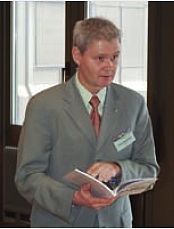
Dr. Reinfried Mansberger at the Symposium in Vienna in 2009.
|
Ir. Liza Groenendijk, editor
FIG Commission 2.
Chair Working Group 2.2. e-learning
Education Portfolio Manager,
Faculty of Geo-information Science and Earth
Observation (ITC), University Twente,
Enschede, the Netherlands
Prof. Dr. Bela Markus
Chair FIG Commission 2.
Professional Education
Head, Land and GeoInformation Knowledge
Center
Faculty of Geoinformatics,
University of West Hungary
Prof. Dr. Steven Frank
Chair elect FIG Commission 2.
Professional education
Department of Engineering Technology and
Surveying Engineering
New Mexico State University, USA
Asst. Prof. Dr. Reinfried Mansberger
FIG Commission 2, Working Group 2.3.
Institute of Surveying, Remote Sensing and
Land Information
University of Natural Resources and Applied
Life Sciences (BOKU Wien)
Dr. Adrijana Car
Coordinator international UNIGIS distance
learning programs at the Centre for
Geoinformatics (Z_GIS), Salzburg University
Senior scientist at the GIScience research unit,
Austrian Academy of Sciences
Dr. James Petch
Founding Director UNIGIS International
Telaman Ltd, Manchester and University of
Manchester
Nicolas Frunzi
Director of Educational Services
ESRI, California , USA
MSc. Pei Linlin
E-learning Specialist
ITC, Enschede, the Netherlands
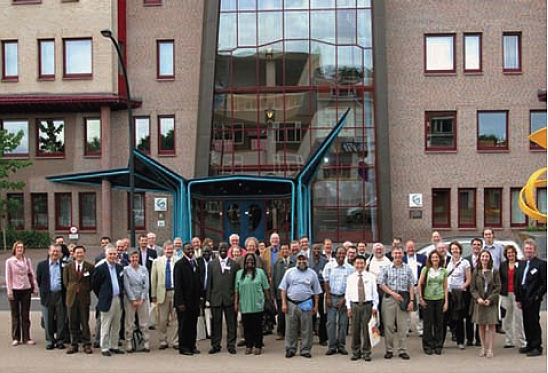
Participants of the e-learning workshop in Enschede in June 2008.
© ITC
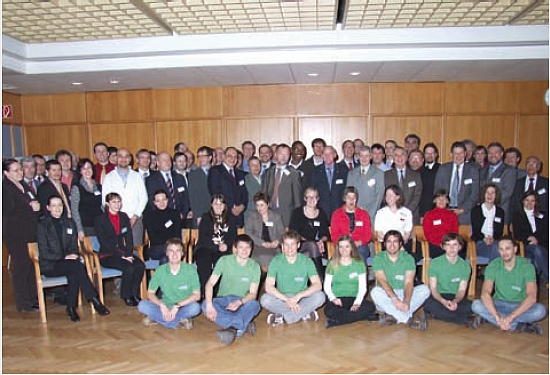
Participants at the Commission 2 Symposium in Vienna in
February 2009.
Published in English
Copenhagen, Denmark
ISBN 978-87-90907-76-1
Published by
The International Federation of Surveyors (FIG)
Kalvebod Brygge 31–33, DK-1780 Copenhagen V
DENMARK
Tel. +45 38 86 10 81
Fax +45 38 86 02 52
E-mail: FIG@FIG.net
www.fig.net
January 2010
ACKNOWLEDGEMENTS
Editors: Liza Groenendijk and Bela Markus
Cover photos: © Gerard Kuster, 2006 (middle); BOKU, 2009 (left), ITC, 2008
(right)
Pictures on courtesy of ITC (www.itc.nl ) and
BEV (www.bev.gv.at)
Design and layout: International Federation of Surveyors, FIG
Printer: Oriveden Kirjapaino, Finland
|

























